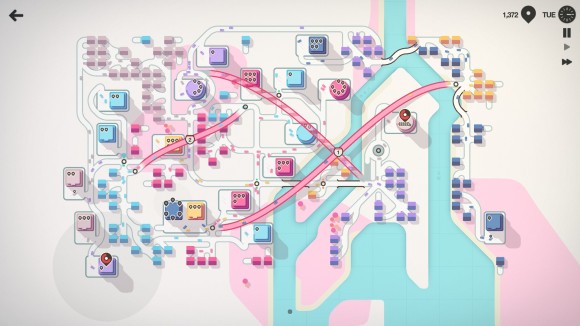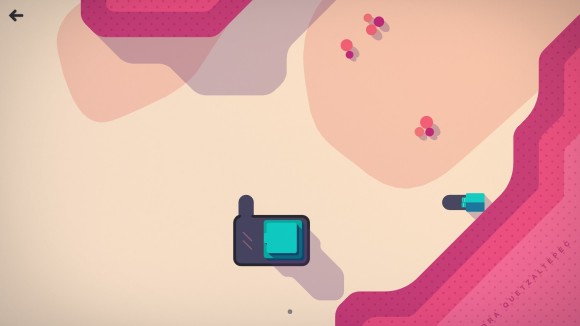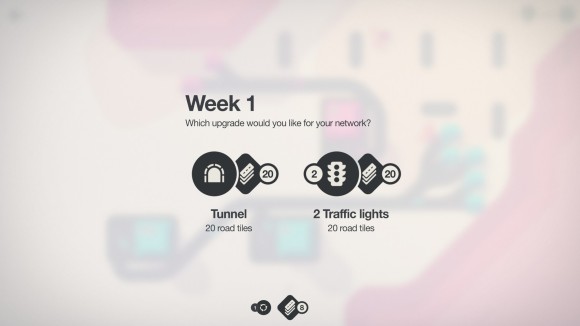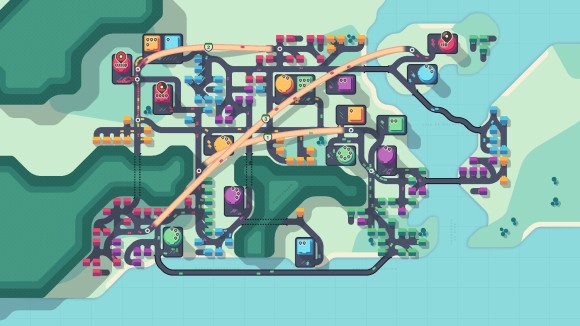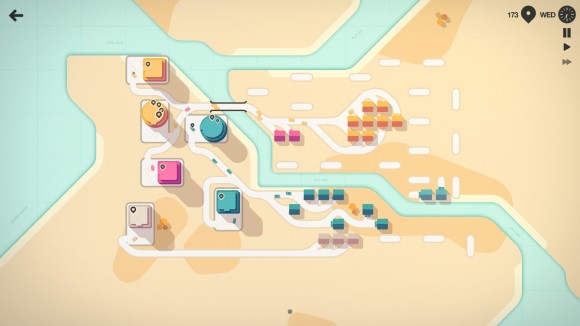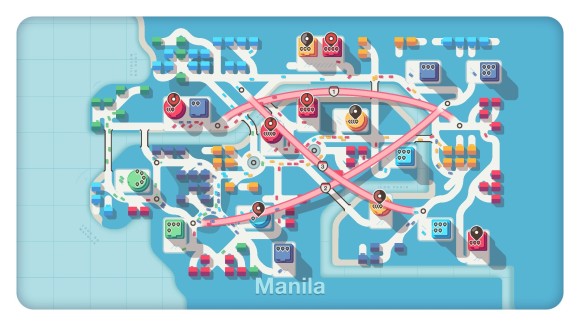It is not remotely surprising to me that Mini Motorways was immediately snapped up by Apple for a couple of years’ exclusivity on Apple Arcade. The game is an extraordinary aesthetic achievement — a perfect blend of rounded edges, pastel colours, minimalist interface and intuitive touch-centric controls that seems to have been laser-targeted at Apple’s UX designers with the intention of sending them into paroxysms of orgasmic joy. I have no doubt that when an iOS developer goes to sleep at night, they dream of things that look very much like Mini Motorways — and not without good reason, either, since Mini Motorways is in many ways the Holy Grail of UX design. I have worked in several organisations that would kill to be able to express the core purpose of their product as simply and as naturally as Mini Motorways does. It’s a pleasure to look at, a pleasure to interact with, and a pleasure to play.
For the first hour or so, anyway.
The more that I play Mini Motorways, though, the more I’m thinking that there was a significant price paid in exchange for its incredible aesthetic qualities: it’s taken the abstraction and simplification of its subject matter way too far to be an engaging long-term prospect as a puzzle game. There is a fine balance to be struck here, and the games that carry it off tend to make it look deceptively easy; I am reminded of last year’s A Monster’s Expedition, which took the basic concept of rolling logs around small islands and successfully spun it out into a 900-level game without it ever getting boring or stale. By contrast I’ve gone through all of Mini Motorways’ dozen city seeds now, and I don’t have the urge to play it any more. It’s not that I have, in some feat of promethean intelligence, somehow solved the entire game and made further runs redundant — my proficiency with the puzzle genre is middling at best — but rather that, because of the limited number of tools and levers available to me as a player, the most reliable path towards “solving” Mini Motorways is one that I have no interest in pursuing.
Let’s get into the basic mechanics so that I can explain why. Every game of Mini Motorways starts by spawning two things onto a blank map: a small coloured house with two cars parked inside it, and a larger destination building matching the colour of the house, which I guess is supposed to represent a generic office or skyscraper or something. If left unattended the destination building will slowly start to accrue pins that represent a journey somebody wants to make to it; the pins can be cleared by building a road between the house and the destination so that cars can travel between the two. For each pin, a car will drive from the nearest house matching the destination’s colour and, when it arrives, the pin will vanish. The car then drives back to the house. As the game progresses more houses spawn along with more destination buildings of different colours, all of which must be connected to one another via roads so that the ever-growing number of journey pins can be dealt with. You’re scored on the number of journeys your cars successfully make over the course of the game, so you already have an incentive to ensure the efficient flow of traffic around the city to maximise this number, but Mini Motorways also introduces a pretty large stick: if a journey pin languishes on a building for too long — say because the car that’s trying to fulfil it has to drive from the other side of the map and got caught up in gridlock along the way because of the two hundred other cars also trying to fulfil their journey pins — then the game ends.
This isn’t really a “lose” condition, because it’s the only way a game of Mini Motorways can end and you’ll always succumb to it sooner or later because of the way the traffic volume in your city seems to grow at a geometric rate — but thanks to that same exponential growth, staving off the end of the game by just a couple more minutes can lead to more successful journeys being made in that period than in the entirety of the game leading up to that point. The car pathfinding is simple, yet effective: each house spawns with two cars which will eventually spend the majority of their time travelling to and from a destination, and while they’re doing that they can’t do anything else, so the game finds the nearest house with an unoccupied car based on the number of road tiles separating it from its goal and tells it to get moving. Once it’s moving it won’t adjust its route from the one that was calculated when it initially set out — in fact if you delete the road it’s supposed to travel over the deletion won’t happen immediately. Instead a ghost road will remain in place and you won’t get the road tiles back until all cars that were going to use it have finished their journeys, which can often mean waiting a minute or two before you can use them for something else.
This refusal of cars to repath when they’re en route to or from a destination has some interesting knock-on effects for the general flow of a game of Mini Motorways. Few things in the game happen immediately; if you notice a junction that’s particularly jammed full of traffic you can’t just quickly plop down some additional roads or redesign the network to address the issue quickly, because the cars that are stuck at that junction honking their horns at one another will just ignore the new routes you put down. It does help, because any new cars that start their journeys after you build the new roads will use them, and so the flow of traffic into the problem junction will be lessened and the blockage will eventually clear, but it will take time. And that’s often time you don’t have; the big, pulsing, game-ending timer that appears when a journey pin has been languishing for too long lasts for a minute or so, but this is not a huge amount of time when the delay between cause and effect in Mini Motorways is at least this long.
So if you want to succeed in Mini Motorways you need to plan ahead and tackle problems before they get out of hand. The thing is, though, the toolset the game hands you to deal with this is not large. There is a timer running alongside the game, and at the end of every in-game week the game will present you with two sets of additional resources to choose from; both will include 20-odd extra road tiles along with one or two of a special item that can make your life a bit easier. These are:
- Bridges and tunnels. Functionally identical, with bridges letting you build roads over rivers and tunnels letting you build roads through mountains. Both consume road tiles along with the bridge/tunnel resource.
- Traffic lights. These are a quick fix for a junction where traffic is all snarled up, as they automatically stop most traffic while cycling through green lights for pairs of lanes.
- Roundabouts. A more permanent alternative to traffic lights, as they allow cars through junctions without stopping unless the roundabout is full.
- Motorways. The most useful item in the game, since they allow you to connect any two points on the map with a motorway that passes over all intervening buildings and roads.
Of these, bridges and tunnels are a necessity on any map with mountains and/or rivers, but since they behave identically to normal roads they’re just an extension of your normal road network. Traffic lights will ensure some traffic gets through a blocked-up junction but they won’t do anything more than that, and can often end up creating knock-on problems elsewhere when traffic that’s stopped at a red light backs up past another junction. Roundabouts are very useful, but they take up a lot of space and often the junctions where you actually need them don’t have room for them, and since you can’t delete or move houses or destinations this means you’re stuffed unless you foresaw where the traffic would go and put down the roundabout ten minutes in advance. This leaves motorways as your sole practical “oh shit” tool when you see journey pins growing out of control, and that’s really not how you want to be using motorways since they should function as arterial roads for general use rather than a specific VIP fast track to a single building.
Since none of these things really solve your ultimate problem of a car population that’s constantly spiralling out of control, what Mini Motorways comes down to, at the end of the day, is how good you are at designing your road layouts. There’s some quick wins here, like slanting all houses so that they enter a trunk road at a diagonal rather than a 90 degree angle as the former lets them easily merge with existing traffic while the latter will stop everything as they pull out. Another surprisingly effective tactic is getting into the habit of putting your roundabouts down early, even if the placement doesn’t look quite optimal at the time. You can also attempt to segregate cars by colour, creating isolated sets of roads that do not connect in order to try and avoid putting too many cars in one place — this is expensive in terms of road tiles, though, and you’ll eventually end up having to connect everything up anyway because of the constant and inexorable rate at which new houses and destinations spawn.
And it’s here that we come to my big beef with Mini Motorways. House and destination spawns are not exactly random, since they are governed by an algorithm that likes to spawn lots of a single colour of a house in one place and then put a new destination for those houses on the other side of the map. However, they are certainly not predictable, and this is poisonous for a game that’s so adamant that I plan ahead when designing a road network. If I have no knowledge of exactly where things are going to spawn, and what colour they are, I am permanently stuck in a reactive mode where I do my best to hook up new neighbourhoods and destinations in a semi-sane fashion as they appear. This is fine, for a while, but eventually the time comes when you want to actually redesign a large portion of the network so that it makes more sense — the actual planning part that Mini Motorways seems to be so fond of — and it’s at this point that the entire thing comes crashing down, as the delay between deleting an object and actually getting it back so that you can use it to build something else is so long that you’ll just break all of your existing transport links without replacing them, causing a massive pile-up of journey pins that eventually kills you. It’s a game that demands prompt action in response to pseudo-random building spawns, but which also tries its best to make that prompt action as difficult as it possibly can.
However, while the building spawns might be pseudo-random, that doesn’t mean they’re totally out of your control. Play Mini Motorways for a while, and you’ll notice that all of the destination buildings are the same size: 2×3 tiles. If there’s no free space that’s at least this large, a building cannot spawn there. Separating your house neighbourhoods from your destination buildings is a good idea in Mini Motorways, as the delays caused by cars pulling out of and into their houses can be catastrophic if those houses have all spawned along the access road to a Tier 2 destination1. So, if you don’t want destination buildings to spawn in a particular area that the game seems to have earmarked for house spawns, all you have to do is block off every single piece of 2×3 space in that area with a chunk of road tile. This has worked almost flawlessly in the three games where I’ve tried it, and it’s boosted my journey score considerably as I can suddenly exert some control over the general direction of traffic from my neighbourhood zones to my destination ones, or at least ensure that destinations don’t spawn in places that would be awkward for me to build new roads to. I haven’t quite figured out the optimal distribution of houses and destinations yet, but it’s only a matter of time.
But that’s the big problem here: I don’t want to play the game like this, and I have no interest in doing so just to get high scores. Obsessively building 2×1 bits of road over half the map is just not my idea of a good time. It certainly doesn’t feel like it’s the intended way of playing, either, it’s just that I have no choice when Mini Motorways has gone to such considerable lengths to abstract away everything that would have made playing it as an actual traffic simulator feasible; aside from the building spawns, the number of things that are actually within your control in this game are surprisingly small. It’s not exactly blessed with depth because of this, and because the long-term motivation is supposed to be driving for ever higher scores on each map (it includes the standard collection of friends leaderboards and so on) I have zero desire to carry on playing because I know that, no matter how high a score I manage to get by playing conventionally, I could always add more to the total by manipulating the building spawns.
(And then there’s the matter of the theming, which, pleasant though it might be to watch ticking along, doesn’t quite sit right with me. I’ll happily spend hours building layouts for an underground network in Mini Metro, and while cars are certainly a significant element of more comprehensive city builders such as Cities: Skylines you’re also desperately trying to shove in as much mass transit as possible so that your city doesn’t descend into gridlock hell. But a game that’s focused solely around bulldozing a pristine wilderness into an asphalt wasteland, just so that you can enable the growth of one of the most inefficient forms of transport for city living? I find that deeply, deeply weird. For some context: I have lived in the UK for all of my life, most of which has been in what passes for medium-size cities here, and I have never needed to drive a car. I can just walk everywhere, or cycle, or get the bus, or the train if I’m going longer distance. And while I know that cars are invaluable if you’re somewhere more remote, or if you’re unable to take advantage of those other modes of transport for whatever reason, in a city I think they’re actively counterproductive to good living. If you build a city with cars in mind you get the tarmac hellscapes that comprise the vast majority of US cities, which are actively hostile to other forms of transport and in fact to human beings in general, and so it is rather strange for me to play a game that is themed solely around doing this.
Perhaps I’m not giving Mini Motorways enough credit, though. No matter what you do, no matter how many traffic lights, motorways and roundabouts you throw into your city, it will just keep growing and becoming more and more congested until it physically can’t accommodate any more cars on the road, at which point it will seize up and die. This could be viewed as wry commentary on the sheer folly on relying on the car as your sole means of transportation in a city — and anyway, I do far more outwardly-offensive things in games like Hitman all the time without ever having to mentally deal with the fact that I would never actually drown someone in a toilet2. Ironically I think it’s the outstanding aesthetic of Mini Motorways that’s causing it to rub me up the wrong way, as it presents cars and roads as being happy, fun, and above all clean, when in my experience the opposite is true.)
I’m probably being a bit too harsh on Mini Motorways here. I got a good four hours out of it clearing all of the levels, for all that the last hour was effectively done under protest; this may not sound like much, but the other thing Mini Motorways has going for it is a very cheap price tag of £7. It’s almost worth paying that just to see it in motion; it’s charming, almost beguiling, to watch the little coloured cars zoom around your toy city for the twenty minutes a game will take you. In fact that is probably the best way to describe Mini Motorways: as a toy rather than a game. It reminds me of a snowglobe in a lot of ways; you spend a bit of time shaking it up and watching the car confetti settle and then you put it down and do something else. Attempting to engage with it on any level beyond that is just going to lead to disappointment. But for £7? Perhaps that’s enough.
- Certain destinations will randomly upgrade themselves to tier 2 as the game progresses, which means they generate more journey pins at a faster rate and consequently need more cars fed into them than tier 1 destinations. ↩
- Although if you put Bezos or Musk in front of me right now I would be sorely tempted. ↩

